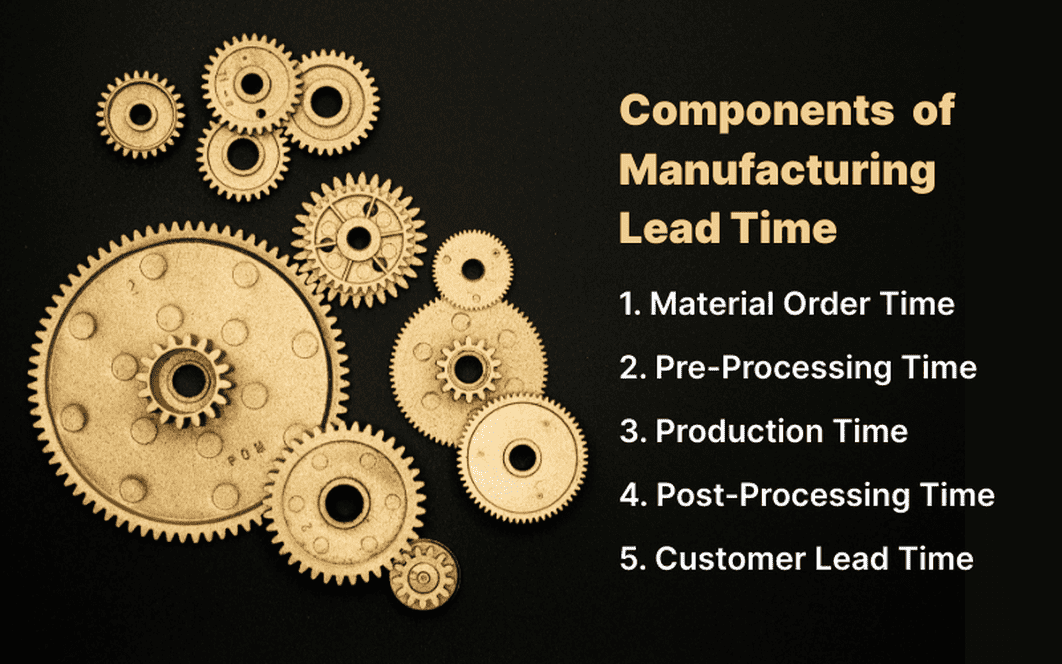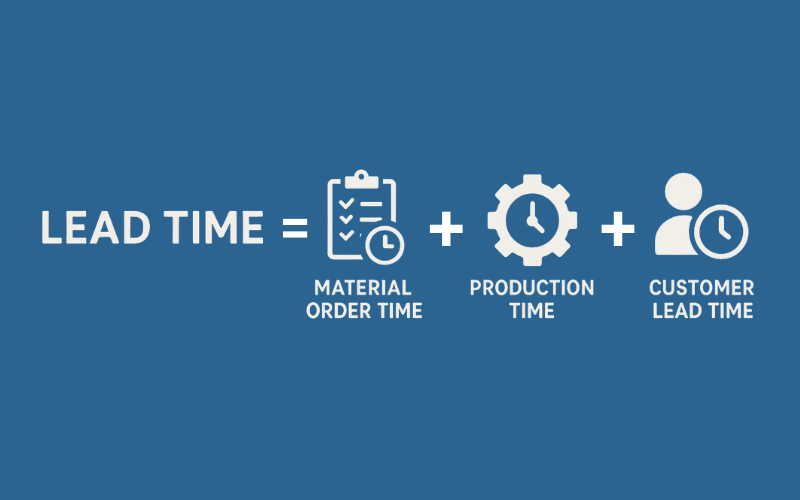Optimize your business: use unlimited savings with Pazago fulfilled now!
Get Started ->Manufacturing lead time plays a major role in how efficiently your supply chain operates. A shorter lead time means faster delivery, better cash flow, and a more responsive business.
Recent data from the HSBC India Manufacturing PMI reveals that supplier lead times in India’s manufacturing sector have shortened at the fastest pace in five months. This improvement highlights stronger inventory management and quicker supplier responses, both essential for reducing overall manufacturing lead times.
If you’re looking to reduce delays, improve production planning, and meet demand more effectively, this guide outlines simple, actionable ways to shorten your manufacturing lead time.
TL;DR
- Manufacturing lead time includes the time from sourcing materials to delivering the final product.
- Long lead times increase costs, reduce flexibility, and hurt customer satisfaction.
- Key strategies to reduce lead time: better inventory control, faster supplier coordination, automation, and real-time tracking.
- Tools like Pazago simplify communication, document management, and shipment tracking to avoid delays.
- Shorter lead times help you stay competitive, respond faster to demand, and improve cash flow.
What Is Manufacturing Lead Time?
Manufacturing lead time is the total time it takes for you to complete a product, starting from when you begin production to when it is ready to ship. It includes:
- Pre-production: The time you spend sourcing raw materials or components
- Production: The time it takes you to manufacture or assemble the product
- Post-production: The time you need for quality checks, packaging, and dispatch
So if it takes you 2 days to get materials, 3 days to produce, and 1 day to package and ship, your total manufacturing lead time is 6 days.
By reducing this time, you can speed up delivery, lower storage costs, and respond more quickly to customer needs.
Next, let’s break down the components of manufacturing lead time so you can identify where delays may occur more effectively.
Components of Manufacturing Lead Time

Manufacturing lead time is made up of several distinct components that together determine the total time taken from order placement to product delivery. Understanding each component helps identify where delays occur and where improvements can be made.
1. Material Order Time
This is the time taken to procure raw materials or components needed for production.
- Includes order placement, supplier processing, manufacturing (if applicable), and transportation to your facility.
- Delays here often stem from supplier reliability, shipping issues, or customs clearance if sourcing internationally.
- Managing supplier relationships and using local or multiple suppliers can reduce this time.
2. Pre-Processing Time
Pre-processing involves all preparatory activities before actual manufacturing begins.
- Tasks like planning, scheduling, inventory checks, and material staging.
- Efficient pre-processing ensures materials and resources are ready, minimising idle time on the production floor.
- Automated systems can streamline these activities, improving accuracy and speed.
3. Production Time (Processing Time)
This is the actual time spent transforming raw materials into finished goods.
- Includes assembly, machining, fabrication, testing, and any value-added steps.
- Production time depends on product complexity, machine efficiency, workforce skill, and process design.
- Techniques like lean manufacturing and automation help shorten this phase.
4. Post-Processing Time
Post-processing covers all activities after production but before shipping.
- Includes quality inspections, packaging, labelling, and storage preparation.
- Efficient post-processing ensures products meet standards and are ready for delivery without unnecessary delay.
- Continuous quality control integrated into production can reduce the time spent here.
5. Customer Lead Time (Delivery Time)
This is the time from product completion to delivery at the customer’s location.
- Covers order fulfilment, shipping, customs clearance (for international orders), and last-mile delivery.
- Choosing reliable logistics partners and optimising shipping methods reduces this component.
- Visibility tools help track shipments and provide accurate delivery estimates to customers.
Knowing what affects your lead time helps you spot delays and speed things up. That keeps production smooth and customers happy.
Also Read: Understanding Steps and Key Elements in the Process of Shipping
Now that you know the basics, it’s time to understand the specific types of lead time you’ll need to track and improve.
Types of Lead Time in Manufacturing

Understanding the different types of lead time involved in manufacturing can help you identify where delays happen and focus your improvement efforts effectively. Here’s a detailed look at the key types:
1. Order Lead Time
This is the total time between when you receive a customer’s order and when the finished product is delivered to them. It includes all internal processes, from order processing to final shipment. Reducing this time means quicker customer satisfaction and improved cash flow.
2. Production Lead Time
Production lead time covers the entire period from when production starts on a product until it is completed. This includes actual manufacturing, assembly, and any in-process quality checks. Streamlining your production lead time improves overall output and capacity.
3. Material Lead Time
This refers to the time needed to procure, receive, and prepare raw materials or components before production begins. Delays here can halt production altogether. Building good supplier relationships and having safety stock can help reduce material lead time.
4. Queue Lead Time
Often overlooked, queue lead time is the waiting period before the production process starts. This can happen if machines or workstations are busy or if jobs wait in line for processing. Efficient scheduling and workflow management can minimise this waiting time.
5. Setup Lead Time
Setup lead time is the time spent preparing machinery, tools, or equipment to manufacture a specific product. This includes changing settings, calibrating machines, or switching production lines. Reducing setup time through better planning or automation can speed up production cycles.
6. Processing Lead Time
Processing lead time is the actual time spent working on the product — cutting, moulding, assembling, or other value-adding activities. Improving worker training, machine maintenance, and production methods can help reduce processing time.
7. Delivery Lead Time
This is the time taken to transport the finished goods from your facility to the customer’s location. It includes packaging, loading, shipping, and transit. Choosing reliable logistics partners and optimising shipping routes can cut delivery lead time.
All these types add up to your total manufacturing lead time. By tracking each separately, you can find bottlenecks, reduce delays, and increase your operation’s responsiveness and efficiency.
Moving on, you’ll learn how lead time differs from cycle time and why both impact how efficiently you deliver products.
Lead Time vs Cycle Time
These terms can sometimes be confusing, but when you compare lead time and cycle time, the main difference is about when the clock starts. Here is what you should know:
While cycle time is useful for measuring how quickly you fulfil orders once work starts, your main focus should be on manufacturing lead time.
Why? Because this is what your customers experience. They don’t see the behind-the-scenes processes or care about internal efficiencies.
They only feel the total waiting time. At the end of the day, customers want their orders delivered quickly, so they can enjoy their product without delay.
Discover how Pazago Visibility helps you track shipments and manage orders in real-time, so you can reduce manufacturing lead time and keep your supply chain on track.
The next section shows you how shorter lead times help you work smarter and deliver faster.
Why Is It Important to Reduce Manufacturing Lead Time?

Reducing your manufacturing lead time can improve your business performance and customer satisfaction. It helps you deliver products faster, save costs, and stay flexible in a changing market.
Faster Delivery to Customers
Shorter lead times mean you can get products to your customers more quickly. This improves customer satisfaction and increases the chances of repeat orders.
Lower Inventory Costs
With reduced lead times, you can keep smaller inventory levels. This cuts down on storage costs and lowers the risk of excess or obsolete stock.
Better Responsiveness to Market Demand
When lead times are shorter, you can adapt production more quickly to changes in customer preferences or market trends. This flexibility helps you avoid overstocking or missed sales opportunities.
Improved Cash Flow
Faster production and delivery mean you get paid sooner, which improves your cash flow and reduces money tied up in work-in-progress or inventory.
Increased Operational Efficiency
Reducing lead time often means identifying and fixing bottlenecks in your process. This can lead to better quality, higher productivity, and smoother operations overall.
An Example of What Happens If You Don’t Understand Lead Time
Imagine you run a small export business and receive a large order from a new international client.
Without a clear understanding of your manufacturing lead time, you might promise a delivery date based on wishful thinking rather than your actual production and shipping capabilities.
As production gets underway, you realise that sourcing materials take longer than expected, and your factory is already handling other orders.
The result? The product ships late, and your client grows frustrated. This delay not only risks losing that order but also damages your reputation and chances of future business.
If you had a clear understanding of your lead time, you could have set realistic expectations, planned resources better, and kept your client informed throughout the process.
Understanding lead time helps you avoid missed deadlines, keeps your customers happy, and strengthens your business relationships.
Also Read: Inventory and Warehouse Management: Differences and Best Practices
Before you plan changes, it’s important to know what long lead times might be costing you, both financially and operationally.
Disadvantages of Long Lead Times

Long lead times can create several challenges that affect both your business and your customers. Here are some key disadvantages to keep in mind:
Missed Sales Opportunities
When products take too long to reach customers, there’s a higher chance they will cancel their orders or buy from competitors. In markets where similar products are available from multiple sellers, customers often choose the one that can deliver the fastest.
Increased Inventory Costs
Long lead times usually mean holding larger inventories to avoid stockouts. This leads to higher costs for storage, insurance, and handling. Excess inventory also risks becoming obsolete or unsellable, which adds to financial losses.
Lower Customer Satisfaction
Customers expect quick delivery, especially with fast shipping becoming the norm. Longer waits can lead to dissatisfaction, hurting your reputation, and making it harder to encourage repeat business.
Reduced Flexibility
With long lead times, adjusting production or responding to sudden changes in demand becomes difficult. This can result in overproduction or shortages, both of which impact your bottom line.
Reducing lead times can help you avoid these issues, improve efficiency, cut costs, and keep your customers satisfied.
Up next, you’ll look into the most common reasons lead times stretch out and what you can do to control them.
10 Key Factors That Affect Manufacturing Lead Time
Many variables can influence how long it takes to complete your manufacturing process. Understanding these factors is essential to spotting delays and improving efficiency.
1. Supplier Reliability
Suppliers who frequently miss deadlines or deliver inconsistent quality can slow down your entire production.
Delays in receiving raw materials cause idle time for your production line. Building strong partnerships, maintaining regular communication, and having backup suppliers help reduce this risk and keep your operations running smoothly.
2. Inventory Management
Managing inventory poorly can lead to stock shortages that halt production or excessive stock that ties up capital and space. Automated inventory management systems with real-time updates ensure you maintain the right balance, so materials are available without overstocking.
3. Production Capacity
Your manufacturing capacity depends on machinery, workforce, and technology. If demand exceeds your capacity, orders pile up, and lead times grow. Investing in scalable equipment, training employees, and scheduling overtime or shifts can help you meet demand on time.
4. Process Complexity
Products with complicated designs or many production steps require more time and coordination. Each additional step introduces potential delays. Streamlining and standardising processes wherever possible can reduce complexity and speed up production.
5. Change Orders or Customisation
Last-minute changes from customers or internal revisions often require rework and rescheduling. These changes disrupt the workflow and add time. Flexible manufacturing systems and clear communication across departments help manage changes with minimal impact.
6. Transportation and Logistics
Even if production is on schedule, delays during shipping, customs clearance, or freight scheduling add to lead time. Optimising shipping routes, consolidating shipments, and partnering with trusted logistics providers reduce these delays.
7. Quality Control Issues
Defects discovered during inspections require rework or replacements, delaying order completion. Implementing strong quality control processes upfront reduces errors and keeps production moving without interruptions.
8. Supplier Lead Time Variability
When your suppliers deliver materials inconsistently—sometimes early, sometimes late—it disrupts your production schedule. Consolidating suppliers, improving communication, and increasing visibility in the supply chain help reduce this variability.
9. Testing and Compliance Requirements
Some products require detailed testing or must meet regulatory standards before shipment. These necessary steps add time to production but are essential.
Balancing thorough testing with efficient workflows helps manage lead time without compromising quality or compliance.
10. Market Demand Fluctuations
Sudden increases or decreases in demand strain your production and supply chain. When demand exceeds your forecasts, delays occur. Improving demand forecasting and building agility into your production helps you adjust quickly and reduce lead times.
By understanding these factors, you can identify bottlenecks and make targeted improvements that shorten lead times, lower costs, and improve customer satisfaction.
Discover how Pazago helps you track shipments, manage suppliers, and streamline your supply chain to reduce manufacturing lead time. Connect with an expert today!
Also Read: Optimising Logistics and Operations Management
In the next section, you will learn how you can measure your manufacturing lead time accurately, so you know exactly where you stand.
How to Calculate Manufacturing Lead Time?

Calculating your manufacturing lead time means adding up the total time needed for each step from when an order is placed to when the product reaches your customer. Here’s a simple way to look at it:
Lead Time = Material Order Time + Production Time + Customer Lead Time
- Material Order Time is how long it takes to get raw materials or parts from your suppliers.
- Production Time is the time spent making the product, including assembly and testing.
- Customer Lead Time covers the time needed to deliver the finished product to your customer.
You can also break lead time down into three stages for better clarity:
Lead Time = Pre-Processing Time + Processing Time + Post-Processing Time
- Pre-Processing Time includes planning, sourcing materials, and preparing for production.
- Processing Time is the active time spent manufacturing the product.
- Post-Processing Time involves inspection, packaging, and delivery to the customer.
Use the first formula when you want a high-level overview of the total lead time across sourcing, production, and delivery.
The second formula is useful when you want to analyse the internal production process in more detail by separating preparation, actual production, and finishing steps.
Both approaches help you identify bottlenecks, but your choice depends on whether you want to focus on the entire supply chain or just the manufacturing workflow.
Also Read: Calculating Chargeable Weight for Air Freight Shipments
Now, let’s explore effective ways you can cut down your manufacturing lead time and boost efficiency.
How Can You Reduce Manufacturing Lead Time?
Reducing manufacturing lead time is essential for improving your operational efficiency, controlling costs, and meeting customer expectations in a competitive market. Below are detailed strategies to help you shorten lead times effectively.
1. Improve Inventory Management
Efficient inventory management is foundational to reducing lead time. When you maintain optimal inventory levels, production lines rarely halt due to missing materials.
- Real-time inventory tracking: Implement inventory management software that updates stock levels instantly. This prevents surprises and allows you to act before stock runs out.
- Automated reorder points: Set reorder levels based on consumption rates to trigger purchases automatically before you hit critical lows.
- Safety stock buffer: Keep a calculated buffer stock to protect against supplier delays or sudden spikes in demand without overstocking.
- Benefits: These practices reduce downtime waiting for raw materials, decrease emergency orders, and help you plan production more reliably.
2. Place Smaller, More Frequent Orders
Large, infrequent bulk orders may seem cost-effective, but often increase lead times due to longer supplier processing and shipping times.
- Agile ordering: Break your orders into smaller batches to allow suppliers to process and ship faster.
- Flexibility: Smaller orders let you respond quickly to changing demand without tying up capital in excess inventory.
- Supplier responsiveness: Frequent orders keep suppliers engaged and better able to prioritise your requests.
- Note: Evaluate whether bulk discounts offset the cost of longer lead times to make the best choice.
3. Strengthen Supplier Relationships
Your suppliers play a critical role in determining your lead time. Strong relationships improve reliability and communication.
- Transparency: Share your sales forecasts, production schedules, and potential changes with suppliers to help them prepare.
- Clear contracts: Include explicit delivery deadlines, quality standards, and penalties for delays or defects to ensure accountability.
- Regular communication: Maintain frequent contact to address issues proactively before they impact production.
- Vendor consolidation: Working with fewer, more reliable suppliers simplifies coordination and improves predictability.
- Outcome: Reliable suppliers reduce delays caused by late deliveries, quality issues, or miscommunications.
4. Streamline Production Processes
Complex workflows increase the chances of bottlenecks, rework, and delays.
- Process mapping: Use tools like value stream mapping to identify waste and non-value-adding steps in your production line.
- Simplify workflows: Remove unnecessary tasks or combine steps to speed up the process.
- Standardise procedures: Create consistent operating methods to reduce variability and improve throughput.
- Continuous improvement: Encourage feedback from production teams and implement lean manufacturing principles regularly.
- Effect: Streamlining increases output capacity and reduces cycle time, lowering your overall lead time.
5. Standardise and Automate Repetitive Tasks

Manual processes are prone to human error and inefficiency, which lengthen production time.
- Automation opportunities: Identify tasks such as material handling, assembly, testing, or packaging that can be automated.
- Standard operating procedures (SOPs): Develop and enforce SOPs to ensure consistency and speed in repetitive tasks.
- Technology investment: Adopt robotics, conveyor systems, or software tools tailored to your production needs.
- Impact: Automation increases accuracy, reduces manual workload, and accelerates manufacturing cycles.
6. Reduce Changeover Time
The time it takes to switch from one product or batch to another directly affects lead time.
- Quick changeover techniques: Train teams on efficient setup processes and use tools that simplify machine adjustments.
- Parallel setup: Prepare the next batch while the current one finishes to minimise idle machine time.
- Maintenance: Keep equipment in optimal condition to avoid delays during changeovers.
- Result: Shorter changeovers increase production flexibility and reduce downtime.
7. Enhance Cross-Team Communication
Misalignment between departments often causes delays and rework.
- Centralised communication platforms: Use digital collaboration tools that allow real-time updates and shared access to production data.
- Regular coordination meetings: Align teams from procurement, production, quality, and logistics to discuss schedules and challenges.
- Clear documentation: Maintain accurate and accessible records of workflows, orders, and changes.
- Benefit: Improved communication reduces misunderstandings, speeds problem resolution, and keeps production on schedule.
8. Forecast Demand Accurately
Aligning production closely with actual market demand avoids overproduction and stockouts.
- Data-driven forecasting: Use historical sales data, market trends, and seasonality to build predictive models.
- Collaborative planning: Involve sales, marketing, and supply chain teams to improve forecast accuracy.
- Adjust production schedules: Update plans regularly based on forecast revisions and real-time sales data.
- Advantage: Accurate forecasting reduces last-minute rushes and balances inventory levels, cutting unnecessary delays.
9. Optimise Transportation and Logistics
Logistics inefficiencies can significantly add to lead times after production is complete.
- Reliable logistics partners: Select carriers with proven on-time delivery records and strong tracking capabilities.
- Route optimisation: Plan shipments to minimise transit times and avoid delays.
- Consolidation: Combine shipments when possible to reduce handling and transit steps.
- Local sourcing: Where feasible, source materials closer to your production site to cut transit times.
- Effect: Improved logistics shorten delivery time and reduce unpredictability.
10. Implement Just-in-Time (JIT) Production
JIT reduces inventory holding and focuses on producing what is needed, when it’s needed.
- Demand-based production: Align manufacturing directly with customer orders to avoid overproduction.
- Inventory reduction: Minimise raw material and finished goods stock to lower costs and storage needs.
- Responsiveness: JIT enables quick adjustment to changes in demand without excess buildup.
- Benefit: Lean inventory and flexible production lower lead times and increase efficiency.
11. Automate Lead Time Tracking and Inventory Monitoring
Manual tracking can lead to mistakes that increase delays and costs.
- Automated systems: Use software to track inventory levels, supplier deliveries, and production status in real-time.
- Alerts and dashboards: Receive notifications for delays or stock shortages before they impact production.
- Data accuracy: Reliable data helps make informed decisions and reduces emergency fixes.
- Outcome: Greater visibility reduces lead time by enabling proactive management.
12. Complete Tasks in Parallel
Sequential production extends the total lead time unnecessarily.
- Process analysis: Identify which steps can be done simultaneously without affecting quality.
- Workflow adjustment: Reorganise tasks to overlap where possible, such as parallel assembly or testing.
- Coordination: Ensure teams have the resources and communication to work concurrently.
- Result: Parallel processing cuts overall production time significantly.
13. Maintain Product Quality While Reducing Lead Time
Faster production should never sacrifice quality, as it directly impacts customer satisfaction.
- Integrated quality control: Conduct inspections and tests at multiple stages rather than only at the end.
- Gradual process changes: Implement improvements incrementally to monitor their effect on quality.
- Employee training: Ensure teams understand quality standards and the importance of adherence.
- Balance: Maintaining high quality prevents costly rework and returns that extend lead time.
- Conclusion: A balanced focus on quality and speed secures long-term success.
14. Use Production Planning Tools

Advanced planning software enhances scheduling accuracy and flexibility.
- Forward and backwards scheduling: Estimate task durations from order start to completion and vice versa to identify the best timeline.
- Drag-and-drop scheduling: Quickly reorder priorities and allocate resources based on urgent needs.
- Real-time updates: Reflect order changes immediately to keep plans current and relevant.
- Benefit: Planning tools reduce downtime, avoid scheduling conflicts, and improve on-time delivery.
15. Analyse Lead Time Data to Identify Bottlenecks
Data analysis uncovers hidden inefficiencies and supports continuous improvement.
- Key metrics: Track average lead time, variability, and forecast accuracy regularly.
- Bottleneck identification: Use data to pinpoint stages where delays frequently occur.
- Predictive analytics: Employ statistical models and simulations to forecast lead time impacts of changes.
- Continuous optimisation: Use insights to implement targeted improvements and monitor results.
- Outcome: Data-driven decisions lead to sustained lead time reduction and better operational control.
Reducing manufacturing lead time demands a comprehensive approach covering inventory, suppliers, production, logistics, and data analytics. Applying these detailed strategies helps you deliver products faster, reduce costs, and improve overall customer satisfaction.
Also Read: Key Components and Importance of Dispatch and Delivery Planning Strategies
How Pazago Supports Reducing Manufacturing Lead Time
Pazago offers a comprehensive platform to help you manage and reduce manufacturing lead times by streamlining key parts of your export and shipping processes:
- Seamless Communication Hub: Coordinate smoothly with agents, freight forwarders, and insurers to quickly resolve issues and avoid costly delays.
- Centralised Document Management: Keep all your shipping and export documents organised and easily accessible in one secure place, reducing errors and speeding up customs clearance.
- Real-Time Shipment Tracking: Monitor shipments live to stay updated on progress and address unexpected issues promptly, protecting your delivery timelines and margins.
- Quality Inspection Support: Ensure your goods meet international standards before shipment to prevent rejections or returns that can affect profits.
- Affordable Logistics Solutions: Optimise shipping routes and reduce freight costs with smart logistics planning.
- Integrated Insurance Management: Manage export insurance policies and claims efficiently within the platform, minimising financial risks from damages or delays.
- Access to Pazago Trades: Use the dedicated trade management portal to oversee your export transactions from start to finish, simplifying management and supporting faster order fulfilment.
By centralising these critical functions, Pazago helps reduce delays and supports smoother, faster delivery of your products.
Conclusion
Reducing manufacturing lead time means fewer delays, better control, and faster deliveries. When your processes are more predictable, your team can focus on what matters most: meeting customer expectations and staying competitive.
Pazago helps by giving you the tools to manage your shipments, documents, logistics, and communication in one place. It simplifies your operations and gives you better visibility and control.
Ready to shorten lead times and improve your supply chain? Talk to a Pazago expert today.
FAQs
1. What is manufacturing lead time?
Manufacturing lead time is the total time it takes to produce a product from start to finish. It includes sourcing materials, actual production, and post-production tasks like inspection and delivery.
2. How do I calculate manufacturing lead time?
Add the time needed for material procurement, production, and delivery.
Formula: Lead Time = Material Order Time + Production Time + Customer Delivery Time
3. Why is reducing lead time important?
Shorter lead times mean faster deliveries, better inventory control, lower costs, and improved customer satisfaction.
4. What’s the difference between lead time and cycle time?
Lead time includes the full process from order to delivery.
Cycle time only includes the time spent actively working on the product.
5. What causes long lead times?
Common causes include unreliable suppliers, poor inventory management, machine downtime, and inefficient production processes.
6. Can software help reduce manufacturing lead time?
Yes. Tools like Pazago, inventory management systems, and production planning software improve visibility, automate tasks, and help reduce delays.


.png)








